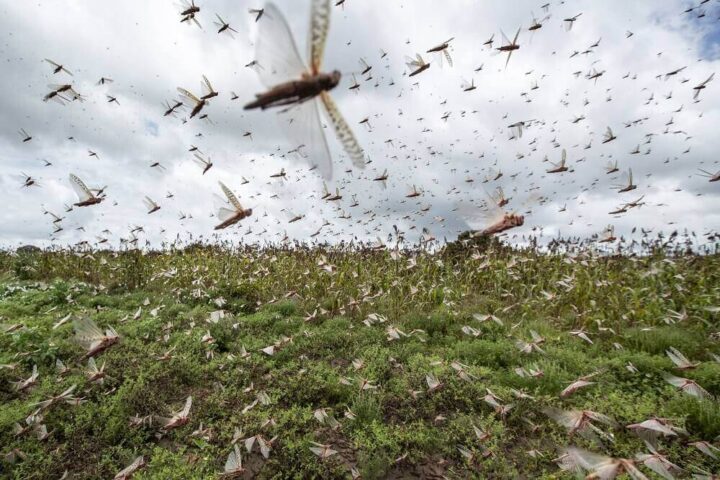Each rainy season over 40 per cent of farm yields in Kenya are lost due to crop pests and diseases like aphids, whiteflies, green mite, stem borer, locusts, Fall Armyworm (FAW), and blight, but most recently, two pests, FAW and desert locusts, have invaded our farms savaging our staple foods and threatening our livelihoods.
In 2017, Kenya lost 16m bags of maize and our yields were reduced by up to 80 per cent due to FAW attacks, while, in the last six months, we have suffered massive food losses as 40 million locusts have descended on Kenyan farms, consuming in one day crops that would have provided food for 35,000 people.
If left unaddressed, these two top hitters could lead to millions in food losses and hunger as the emergence of the Covid -19 pandemic has additionally hampered food imports. It is thus vital for farmers to be well equipped in how to identify and mitigate these pests, for #EveryCropCounts now more than ever.
How to identify the desert locusts and hoppers
Desert locusts have a three-stage life cycle; egg, hopper and adult. The immature locusts are pink and only hop, while the mature adults are bright yellow and fly during the day, sometimes in dense swarms. Hoppers are two to three millimeters long, while the flying locusts are about six to eight millimeters. They travel in packs of up to 80 million locusts, known as a swarm, which can cover almost 1,200 square kilometres at a time. In dense hopper bands, produced as a result of laying by a swarm, the young hoppers are black, but as they get older the black markings become proportionately smaller and a yellow background colour develops.
Calling in government sprayers
Hoppers and adult locusts can be controlled with chemicals sprayed from the air or from the ground. The best method will depend on the farming system, environment, locust population, available equipment and technical capability. However, the locusts are most vulnerable at the early hopper stage, so they should be sprayed as quickly as possible after hatching, before they develop into flying locusts.
For this, the Pest Control and Produce Board (PCPB) has identified a list of 64 active pesticide ingredients that can be used. But they can only be used in Ultra-Low Volume formulation (ULV), in order to effectively kill the locusts without any other impact on the environment or wildlife.
In that locusts are also strategic pests and highly migratory, the necessary spraying isn’t viable for individual farmers, who instead need to alert the Ministry of Agriculture – through its county offices, its social media pages or through the Agrochemicals Association of Kenya – so that it can arrange spraying as quickly as possible.
The spraying is highly specialised, in that:
- The undiluted active ingredients that are ablest to fight the locusts require specialized ultra-low volume applicators that are not widely available locally.
- Locust sprayers need specialised training and types of vehicles and must know how to mix the pesticide ingredient, what quantities to use and the type of equipment to use, such as knapsacks.
For these reasons, the government has trained 600 youth from the National Youth Service and army personnel to carry out the spraying.
For farmers seeking to protect their own crops ahead of the ministry spraying, mechanical barriers, such as shade nets and green houses, can help keep the young locust off.
But ministry spraying should be swift after being alerted. Since the arrival of the desert locusts in December 2019, the Kenyan government has procured six aircrafts for spraying and four for surveying, and distributed more than 24,000 litres of the FAO-recommended pesticides used in spraying.
Aerial spraying has been carried out to deal with flying locusts in Samburu, Laikipia, Isiolo, Kitui, Machakos, Marsabit Garissa Meru, Tharaka Nithi, Mbeere and Mandera counties.
Shortages of equipment, personnel, additional vehicles, personal safety equipment, planes, GPS units, camping equipments and radios, all of which are key resources, have slowed some of the mitigation efforts. Responses were also delayed by shortages of pesticides, but the Agrochemical Association of Kenya reported in April 2020 that its members had stocked over 200 tonnes of the 64 pesticides recommended by the PCPB.
Currently, the trained spray team are preparing for the third wave of locusts, as the next round of eggs hatch into hoppers.
For advice and further information on controlling locusts, farmers are advised to contact:
- The Ministry of Agriculture through its county offices or through its social media pages on Facebook or Twitter.
- The Agrochemical Association of Kenya on our Facebook page @agrochem.croplifekenya, Twitter; @CropLifeKenya or contact us at +254 734447777, +254 710447777
- The Pest Control and Produce Board on http://www.pcpb.go.ke/crops/


